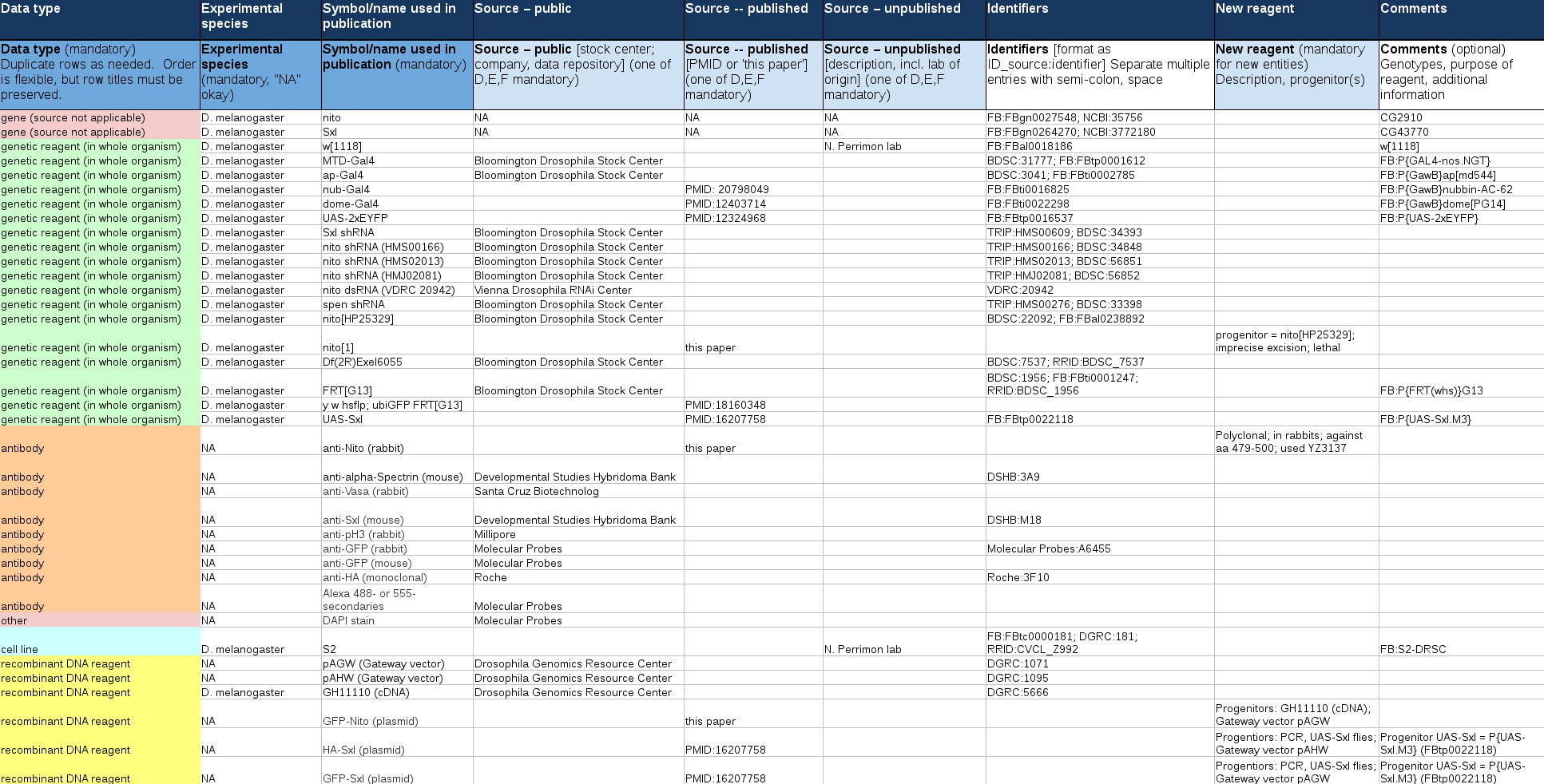FlyBase:Author Reagent Table (ART)
Rationale and Purposes
Wider use of identifiers and recognized symbols increases the transparency and reproducibility of biological research, while aiding curation into research databases.
A spreadsheet format is convenient and flexible for the researcher and provides commonly used download options for readers of publications.
The table is designed to be used regularly during the course of a research project, recording reagents as they are received and/or used. Lab-wide use of a common reagent form would facilitate tracking of reagents within the lab.
Providing information in a structured format that allows bulk downloads greatly facilitates curation into research databases.
In addition to reagents, unambiguous identification of specific genes studied is particularly helpful for genetic and genome databases, as well as for the larger research community.
Guidelines for creation of the Author Reagent Table
| Download template in XLSX format |
Some of the constraints below are imposed to allow automated parsing of the table.
Columns (general):
- Column order and headings must be preserved.
- Columns A-I should not be removed, even if not used.
- Columns can be appended (J, K, etc.) for internal use.
Rows (general):
- Row titles must be preserved.
- Row one (column headings) should not be removed; row 2 (headings with instructions) may be removed.
- Order of the rows can be changed.
- Clustering of multiple reagents of one type recommended, but is not mandatory.
- Colors are entirely optional: can be removed or changed.
- Data types indicated on template that are not used can be removed.
- Data types not represented in the template: use “other”. (If appropriate, contact us about adding a category.)
Column A: Data type (mandatory)
- Row titles cannot be changed
- See additional information in the section “Rows (general)” above.
Column B: Experimental species (mandatory)
- Use genus initial with full species OR full genus and full species
- Use “NA” rather than leaving blank
Column C: Symbol/name used in publication (mandatory)
- This is a free-text field (no formatting constraints, except for separation of multiple entries by semi-colon, space).
- Should indicate exactly how the reagent is referred to in the publication. If several designations are used for one reagent, can include more than one entry, separated by semi-colon, space. If one designation has been used to refer to several different reagents, list each reagent separately and include a unique identifier of some sort.
Columns D-F: Source (one of D-F mandatory)
- Use of multiple columns allows sorting of source information into public repositories, publications, and laboratories.
- In order of preference: use column D, if possible.
- Columns D and F are free-text fields.
- Column E should be in the form of a PubMed ID or the text “this paper”.
Column G: Identifiers (not mandatory; use if possible)
- Use the format “ID_source:identifier” with a colon and no spaces. Separate multiple entries with a semi-colon, space.
- If possible, use the recommended abbreviation for the ID_source (see below)
- Multiple identifiers, even if redundant, are useful for validation. In some case a more general identifier (for a stock, for instance) can be combined with a more precise identifier (for the allele of interest in that stock).
- Inclusion of database identifiers is strongly encouraged to facilitate accurate incorporation of published data into appropriate biological databases.
Column H: New Reagent (mandatory for newly described reagent)
- Use if “this paper” entered in Column E
- Free-text field (no constraints on format).
Column I: Comments (optional)
- Free-text field
- For public consumption
Additional columns can be added for internal purposes (and removed prior to submission for publication): tracking acquisition by the lab, lab-specific stock numbers, storage location in the lab, comments about problems or QC, etc.
Example of Completed Author Reagent Table
Download an xlsx version of the example below.
